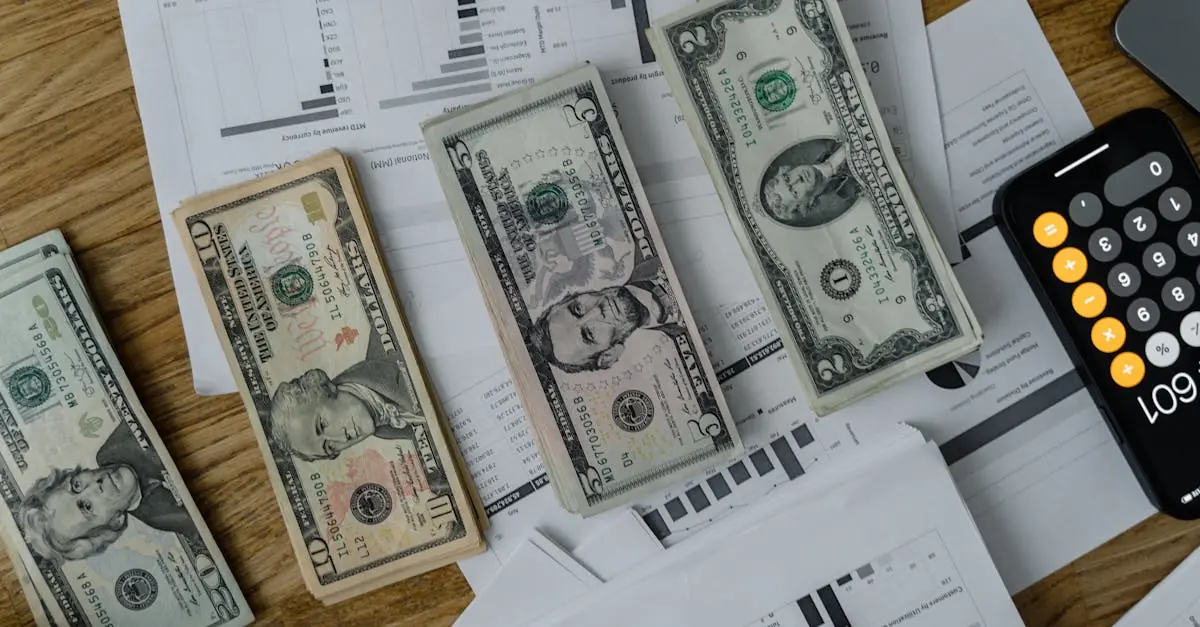Ever wondered why your paycheck seems to vanish faster than a magician’s rabbit? Enter the world of “pay yourself first budgeting,” a game-changing strategy that flips the script on traditional money management. Instead of letting bills and expenses hog all the spotlight, it puts you front and center—because let’s face it, you deserve that front-row seat.
Table of Contents
ToggleWhat Is Pay Yourself First Budgeting?
Pay yourself first budgeting focuses on saving before addressing expenses. This method emphasizes setting aside a portion of income for savings immediately upon receiving it. Individuals often prioritize their savings to build financial security without waiting until after paying bills.
This strategy allocates a percentage of income directly to savings or investments. Setting up automatic transfers to savings accounts provides consistency. By treating savings as a non-negotiable expense, individuals reinforce financial discipline.
Many financial experts recommend saving 20 percent of income each month. Allocating this percentage to savings fosters a habit of prioritizing personal finance. Personalities open to this approach find it easier to build wealth over time.
People adopting this practice may experience reduced financial stress. Less worry occurs because they establish a safety net through consistent savings. Those engaged in pay yourself first budgeting often note a sense of accomplishment when reaching savings goals.
This budgeting style allows flexibility in managing remaining funds for monthly expenses. Individuals can adjust their spending habits to align with their savings ambitions. Spending less on non-essential items becomes easier when savings take precedence.
Many individuals successfully integrate this strategy into their monthly routines. Ultimately, pay yourself first budgeting empowers people to take charge of their financial futures.
Benefits of Pay Yourself First Budgeting
Pay yourself first budgeting offers several advantages that enhance financial well-being. This method leads to increased financial security and fosters improved savings habits.
Financial Security
Savings act as a financial cushion for unexpected expenses. Individuals building up their savings create a sense of security against job loss or emergencies. Allocating money immediately upon receiving income can help achieve this cushion. Owners of savings accounts typically find comfort in knowing they have funds reserved for crises. The practice decreases reliance on credit, helping to prevent debt accumulation. Ultimately, enhancing financial security reduces anxiety and promotes overall peace of mind.
Improved Savings Habits
Individuals who implement this budgeting strategy often notice a shift in their saving behaviors. Consistently setting aside a portion of income encourages a habit of prioritizing savings. Monthly saving routines typically lead to better financial discipline. Recurrent deposits make saving an automatic process, reducing the temptation to spend. Over time, increased savings contribute to achieving larger financial goals. This positive reinforcement fosters healthier spending habits, supporting a consistent commitment to financial growth.
How to Implement Pay Yourself First Budgeting
Implementing the pay yourself first budgeting method involves strategic planning and commitment. It centers on setting clear guidelines and ensuring disciplined savings behaviors.
Setting Financial Goals
Establishing financial goals starts with defining both short-term and long-term objectives. Short-term goals may include building an emergency fund or saving for a vacation. Long-term goals often involve retirement savings or purchasing a home. Prioritize these goals by determining which are most important and how much needs to be saved for each. Categorizing goals helps in allocating appropriate funds. The 20 percent recommended savings rate can significantly impact achieving these goals. Regularly review and adjust goals based on changing circumstances or financial milestones to maintain clarity and focus.
Creating a Monthly Budget
Creating a monthly budget follows goal-setting and focuses on turning aspirations into actionable plans. Begin by calculating total monthly income, including all sources like salaries or side gigs. Next, identify fixed expenses such as rent or utilities, alongside variable costs like groceries or entertainment. After accounting for these expenses, determine the amount needed for savings under the pay yourself first method. Allocate 20 percent to savings immediately upon receiving income, then assign the remaining funds to discretionary spending. Tracking these expenditures throughout the month ensures alignment with financial goals. Consistent adjustments refine the budget, leading to improved financial health over time.
Common Mistakes to Avoid
Understanding common errors in pay yourself first budgeting can enhance effectiveness. Awareness of these pitfalls helps individuals maintain financial discipline.
Overlooking Expenses
Many individuals underestimate their monthly expenses. Failures in recognizing all obligations lead to budgeting gaps. List all fixed and variable expenses to avoid surprises. Some may forget irregular expenses, such as annual subscriptions or seasonal costs. Collectively tracking these items supports better financial planning. A comprehensive overview helps allocate appropriate funds for saving, ensuring the budget remains balanced.
Ignoring Savings Adjustments
As income or expenses fluctuate, savings goals require updates. Complacency can jeopardize financial progress. Regularly revisiting savings percentages reinforces commitments. Individuals might start with 20 percent but overlook adjusting that amount when financial situations change. Recognizing personal milestones or unexpected expenses should prompt immediate action on savings adjustments. Adapting strategies aids in meeting both short-term and long-term financial goals efficiently.
Adopting the pay yourself first budgeting method can significantly transform one’s financial landscape. By prioritizing savings from the very start, individuals foster a proactive approach to their finances. This strategy not only builds a safety net but also cultivates healthier spending habits over time.
With consistent practice and commitment to financial goals, the sense of accomplishment grows as savings increase. It’s about taking charge of one’s financial future and reducing stress associated with unexpected expenses. Embracing this budgeting technique can lead to lasting financial security and peace of mind.



